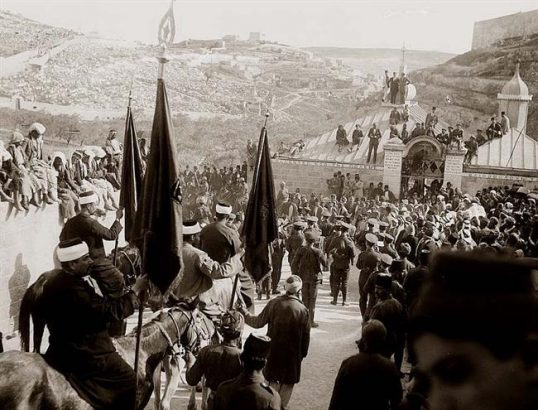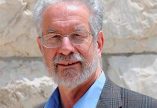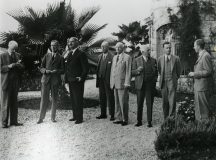Fathom is marking the 100th anniversary of the beginning of the British Mandate with a series of essays. Yisrael Medad explains why 1920 was such a pivotal year in the Arab conflict with Zionism.
The year 1920 marked a year of Zionist achievement but it also saw the launch of the conflict between Jews and Arabs. It was the year in which, following the 1919 Versailles Peace conference, the Principal Powers who represented the victors decided at San Remo in late April to entrust the administration of Palestine to a Mandatory responsible for fulfilling the Balfour Declaration in favour of the establishment in Palestine of a national home for the Jewish people. It was the year in which the civilian British administration, on 1 July, replaced an oppressive five-century long Ottoman Empire rule as well as two-and-a-half years of British military government. It was also the year when the first politically-instigated Arab anti-Zionist riots broke out in Jerusalem on 4 April, resulting in Jewish civilian deaths.
All in all, it was the year the Arab conflict with Zionism commenced; and the year a future war for liberation with the nascent British Mandatory regime began.
British sympathy to Zionism – The Path to Restoration
Great Britain was the home to what has been termed Restorationism, the movement among Christians which advanced the return of the Jews to their national status in their historic homeland. Beginning in the 17th century and gaining strength in numbers and a growing influence among the political elite, it was formulated in 1864 by C H Spurgeon who believed that if the New Testament text ‘words mean anything, first, that there shall be a political restoration of the Jews to their own land and to their own nationality’.
In 1827, Menachem Mendel of Shklov, the leader of the students of the Vilna Gaon who had immigrated to Ottoman Palestine, met with representatives of Christian missionaries, seeking, through them, to draw British officialdom to Jerusalem. Indeed, in 1838, a British consulate was established in Jerusalem. In 1840, the Foreign Secretary Lord Palmerston, under the influence of Lord Shaftesbury, sought to get the Turkish Sultan to adopt the idea of a ‘return’ of the Jews and encourage them to settle in Palestine. The industrialist Edward Cazalet called for the establishment of a British protectorate over Palestine in his 1879 England’s Policy in the East: Our Relations with Russia and the Future of Syria. A year earlier, Laurence Oliphant began advocating for Jewish settlement in the country. In 1903, British Colonial Secretary Joseph Chamberlain presumed that ‘there would be no difficulty in finding land suitable for Jewish settlers’ in East Africa and subsequently suggested to Theodor Herzl some 13,000 square kilometres at Uasin Gishu in today’s modern Kenya.
World War One Provides an Opening (And An Opportunity)
Against this background and given the composition of the British government, it was not unremarkable that Palestine’s ‘destiny’ was first deliberated in the British Cabinet on 9 November 1914, just days after Britain had declared war on the Ottoman Empire. Following the official meeting, Herbert Samuel was told by Chancellor David Lloyd George, who had introduced the discussion, that he was very keen to see a Jewish state established in Palestine’. In his 7 January 1915 summary of a conversation, Chaim Weizmann noted that Samuel ‘believed that big things would have to be done in Palestine … The Jews would have to bring sacrifices and he was prepared to do so … perhaps the Temple may be rebuilt … in a modernised form’.
After discovering that the January 1916 Sykes-Picot Treaty had assigned the area of Palestine to an international regime, Zionists in England effectively thwarted that intention. As Weizmann observed, it was ‘fatal to us…. The Sykes-Picot arrangement was not a full treaty; but it was sufficiently official to create the greatest single obstacle to our progress.’ At the same time, Ze’ev Jabotinsky was engaged in furthering his initiative for an exclusive Jewish military unit that would fight on the side of the Allies and participate in the liberation of the Jewish homeland, building on the precedent of the Zion Mule Corps. These two activities not only achieved their immediate goals but were the foundation for the issuance of the Balfour Declaration on 2 November 1917. As The Times headline made clear, the government had no illusions what its declaration intended: ‘Palestine for the Jews’.
With Jerusalem taken by Allenby during Chanukah, on 9 December, five centuries of Ottoman rule came to end. Jews believed they could look forward to immigrating freely, to resettle on the land, to purchase it and develop it and, eventually, to achieve political independence. By April 1918, a Zionist Commission, a joint British and World Zionist Organization body entrusted with making recommendations regarding the settlement and development of the country, had arrived in Occupied Palestine to ensure the military government acted in line with the British government’s policy. On 13 October 1918, then running in his first election campaign, Neville Chamberlain addressed an audience at the Alexandra Theatre in Birmingham and stated he foresaw ‘Zionists, who before long will be proceeding with joy in their hearts to the ancient seat of their people’ and added, ‘Theirs will be the task to build up a new prosperity and a new civilisation in old Palestine, so long neglected and misruled. They will carry with them the hearty goodwill of the British nation.’
But those serving on General Allenby’s staff were of another mind. Their sympathies, coloured by antisemitism, lay with the Arabs.
The Arab Awakening
Jabotinsky’s letter to Weizmann of 12 November 1918 details the inception of the future violent developments:
But all came to a head on the 2nd November. As you know, we had orders from you to celebrate the day – I must confess I personally was not in a mood for celebration, but since it was desired in London, efforts were made to arrange the thing decently. In both Jerusalem and Jaffa, Arab notables made representations to the government protesting against the proposed festivities. In Jerusalem … the procession was advised by Major Hadad Bey not to pass the Jaffa Gate, which they obeyed, but two schools – all [Jewish] children living in the Old City – had to go that way anyway. They were attacked by a group of Arabs; children and teachers were beaten and blue-white banners torn. Two of the ruffians were arrested and sentenced to 4 months imprisonment … But in the meantime the same Arab notables made a step of much greater importance. On the morrow of the celebration a deputation of about two hundred Arab leaders, Moslem and Christian, headed by the Mayor of Jerusalem Kazim Husseini (the Mufti did not go this time) presented to the Governor a petition….
By early 1919, Muslim-Christian Associations, which had begun to organise a year earlier, felt able to convene a Congress and continued their efforts through the coming months with one major demand: the unity of Palestine and Syria. Several of their more public activities were curtailed by the military government but the Arab population was indeed being mobilised. As even Aharon Cohen, of Mapam and the pro-binational League for Jewish-Arab Rapprochement, noted in his 1947 testimony before UNSCOP, ‘Ever since its inception, there was a trend in the Mandatory Government of Palestine to encourage the Arabs to oppose the establishment of the National Home promised the Jews in the Balfour Declaration and in the Mandate. After the first riots in Palestine in 1920, high Government officials were accused of being guilty concerning their outbreak — as testified in the Protocols of the Shaw Commission in 1930’.
When Weizmann had met with Balfour in January 1918, the two had agreed on immediate goals for the Zionists in Palestine. They would work to build up the existing Jewish population and to establish a Jewish University, although they would initially not be permitted to purchase any land.
Writing to Balfour at the end of May, Weizmann requested that the Wailing Wall be transferred to the Jews but on 16 June Major-General Gilbert Clayton, the first Chief Political Officer, opined to the Foreign Office that the Jewish purchase of the Wailing Wall should be rejected. He pointed out that the Wall was very close to the Dome of the Rock and that it was actually part of its environs. Therefore, it was likely that Jewish purchase of this property would raise a storm of protest, and for that reason, he could not assent to it. The rights to and at the Western Wall would flare again in May 1920, 1925 and, murderously, in August 1929 after a period of 10 months following the British insistence on fixing a ‘status quo’ that severely restricted Jewish rights at the holy site (and would be resurrected by Moshe Dayan in June 1967 to be applied at the Temple Mount).
The Stumbling of the British
The British administration was turning out to be far less sympathetic than the Zionist leaders expected. Indeed, too many of the senior British military official administrating Palestine were unfriendly to Zionism and the idea of a Jewish National Home. Ronald Storrs, in his memoirs, (pp. 381-83), was candid: ‘It cannot be denied that there were amongst us two or three officers in high positions overtly against the declared policy of H.M.G. As pointed out by John J. McTague Jr., these were, , Gilbert Clayton, the Military Administration’s three Chief Administrators – General A.W. Money, Major-General H.D. Watson and Major-General Louis Bols – and Clayton’s assistant, Major J.N. Camp. Lieutenant-Colonel John Hubbard, the Military Governor of Jaffa and later Nablus, was openly disdainful of Jews as was Lieutenant-Colonel L.R. Waters-Taylor, a financial adviser to the Military Administration. After a May 1920 visit to the country, Major-General William Thwaites, the Director of Military Intelligence, expressed fear of undue favouritism to the Jews. He found, as he wrote in a 21 June 21 1920 memorandum that a majority of the soldiers in Palestine agreed with his point of view that ‘there is a general unwillingness among the British troops to support a pro-Zionist policy. They are not exactly pro-Arab, but prefer the Arabs very greatly to the Jews.’ In due course these were eliminated (for only one saw fit to resign).’
It would be later, during the 1920 riots, as Storrs relates, that the Mayor of Jerusalem, Musa Kazim Pasha al-Husayni, ‘became first intractable and then defiant’ and he was dismissed by the District Governor in an unusual forceful British move. Raghib al-Nashashibi, of a rival clan, was appointed in his place. Although all this happened before Samuel took up his post, it need be noted that a year later, through the efforts of the anti-Zionist Ernest T. Richmond, the infamous Amin el-Husseini became the Mufti, a move that placed a fanatic at the very centre of Mandate politics for decades to come.
Moreover, in addition to promoting the partition of Palestine and the establishment of Trans-Jordan ruled by Abdullah, Samuel first suggested an ‘Arab Economic Union’ in 1920 and then another Arab unity scheme in a letter to the Secretary of State of 12 December 1922, proposing a Confederation of Arab States to include the Hijaz, Syria, Palestine, Transjordan, Iraq and possibly Najd. The President of the Confederation would be King of the Hijaz.
The one outstanding local pro-Zionist official was Colonel Richard Meinertzhagen who was appointed Chief Political Officer in August 1919, replacing General Clayton. A realist, he wrote to Lloyd George in March 1919 that the Jews and Arabs would definitely clash in the future, because Jewish development would be seen negatively by the local Arabs. He bemoaned the lack of a clear policy supporting the Balfour Declaration and argued that ‘the Palestine Administration must be purged of those elements hostile to Zionism.’
Trouble from the North
As 1919 drew to a close, it became obvious that there was a bestirring amongst the Arabs throughout the Middle East. The King-Crane Commission’s report, which concluded that ‘There would then be no reason why Palestine could not be included in a united Syrian State’, was not published and Arab political figures assumed there was no intention to fulfil such an idea. The future April 1920 meeting of the Allies in San Remo became known. Faisal was becoming unwelcome to the French in Damascus. In late February 1920, there were public gatherings of protest in Jerusalem, Jaffa and Haifa and petitions were presented to the authorities. On 8 March however, in Jerusalem, Arabs marched from the Old City to the Augusta Victoria Hospice on the Mount of Olives, then back towards Jewish neighbourhoods whereupon the Arabs attacked passers-by, wounding several. They had been shouting such slogans as ‘Death to Jews’ or ‘Palestine is our land and the Jews are our dogs!’
The convening of the Second General Syria Congress in Damascus on March 8 produced a repudiation of the Mandate idea and proclaimed Syrian independence, Faisal as King, and Palestine was recognised as ‘Southern Syria’. This principle had been already accepted by the First Palestine Arab Congress of 1919 and the Second on 27 February 1920, held in Damascus.
To comprehend the events of 1920, it is critical to understand that at that time, and for several years after, Palestine was not considered to be a separate geo-political entity but rather part of Bilad al-Sham, or Greater Syria. Faisal had communicated to General Allenby that Palestine ‘is an inseperable [sic] part of Syria’. Even Shukri Ghanim, his pro-French rival, opined that Palestine is ‘incontestably the Southern portion of our country.’ Even very pro-Palestinian Israelis, such as Kimmerling and Migdal, have written that a January 1919 Palestinian Arab conference under the auspices of the Jaffa and Jerusalem Muslim-Christian Associations agreed that Palestine would be part of a federated, Faisal-led Syria.
Daniel Rickenbacher’s 2017 PhD dissertation details that in December 1918, the New Syria National League of Phillip Hitti and George Khairalla lobbied for the establishment of a Greater Syria, from the Sinai to the Euphrates, under American protection and reached out to John Huston Finley, the chief of the Red Cross Commission in Palestine, asking him not to detach Palestine from Greater Syria. Moreover, a telegram was sent to President Woodrow Wilson, Lloyd George and Georges Clemenceau at the Versailles Peace Conference advocating such an American protectorate. Incidentally, efforts were to continue all throughout the 1920’s to rejoin Palestine to Syria. In 1926, Lieutenant-Colonel G. S. Symes, Chief Secretary of the Administration of the Palestine Mandate informed the League of Nations Permanent Mandates Commission that:
The Pan-Arab politicians hoped for an eventual amalgamation of all Arab-speaking countries, and they disliked any system under which Palestine, Syria and Iraq were treated as separate territories… certain of the Arab politicians suggested that the country should be called ‘Southern Syria’ in order to emphasise its close relation with another Arab State.
Violence Erupts
Secret societies began to be constituted. There was the Ikha w’al ‘Afaf which had attempted to infiltrate the Muslim Indian troops who were stationed in the country as well as Arab members of the police. Another was the al-Yad al-Sawda, or the Black Hand. Legal political groups, such as the Muntada and Nadi were linked to these illegal societies who were encouraged to arm.
All this agitation, local and Syrian, primed the violence that was increasing in Mandatory Palestine. The British had transferred the Upper Galilee’s ‘Finger’, with its Tel Hai, Metulla, Hamrah and Kfar Giladi Jewish communities to French jurisdiction. Arabs, opposed to French rule over Syria, suspected the Jews of pro-French sympathies and, during a forceful search for arms, Shiite Arabs from Jabal Amil in southern Lebanon killed eight of Tel Hai’s residents on 1 March 1920.
The Arab-Zionist tension increased and between 4-7 April during the Passover Festival and Muslim Nebi Musa Festival (with Good Friday falling two days earlier) tens of thousands of Arabs converged on the Old City of Jerusalem. Inflamed by speeches, they then fell upon the Jews. Here is what Khalil al-Sakakini recalled watching:
[A] riot broke out, the people began to run about and stones were thrown at the Jews … there were screams … I saw one Hebronite approach a Jewish shoeshine boy, who hid behind a sack in one of the wall’s comers next to Jaffa Gate, and take his box and beat him over the head. He screamed and began to run … The riot reached its zenith. All shouted, ‘Muhammad’s religion was born with the sword’ … my soul is nauseated and depressed.
Five Jews and four Arabs died in the riots. Two-hundred and sixteen Jews were injured, 18 critically, and 23 Arabs, one critically. About 300 Jews were evacuated from the Old City. Isaiah Friedman accepts, as others, the argument that Waters-Taylor, the chief of staff for Major-General Bols, the military governor, deliberately facilitated the riots to occur.
As Steven Wagner notes, a verbatim record exists of a meeting held before the Nebi Musa procession between Storrs, Jamal al-Husseini, ‘Aref al-‘Aref , Fakhry Nashashibi and others. It points to Storrs’ blind trust in these leaders and their supposed ability and willingness to control their followers. Aref al-‘Aref, editor of the Suriyya al-Janubiyya (Southern Syria, i.e., Palestine) newspaper, had recently come from Damascus and it seems he opposed violence, demanding that no arms be carried in the procession. But that was not to be.
The International Community decides on the direction of the Mandate
And so, the convergence of interests, visions, hopes and intentions all came together in April 1920. Arab opposition, expressed for the first time in an organised political instrument of mass violence targeting Jews, never yielded on its use of arms. Diplomacy was always a second choice, if employed at all.
Within the next two years, the League of Nations decided the Jewish people’s national home – deriving from the historical connection of the Jewish people with Palestine – would be reconstituted; Jewish immigration under suitable conditions would be facilitated; and that close settlement by Jews on the land, – including State lands and waste lands – would be encouraged as the text of Article 6 of the Mandate decision makes unmistakably clear. Yet it also decided that the area east of the Jordan would be denied to Jews.
In the wake of additional waves of Arab violence in May and November 1921, the 1922 White Paper would severely curtail immigration so as not to exceed the economic capacity of the country to absorb new arrivals. Churchill, as Colonial Secretary, accepting Samuel’s advice, announced that the Balfour Declaration itself would be interpreted as not contemplating that Palestine as a whole should be converted into a Jewish National Home, but that such a Home should be founded ‘in Palestine’.
A quarter of a century later, after much blood, recriminations and a Holocaust in Europe, Britain would leave Palestine, the Arabs would refuse a compromise and a state, and the Jews would regain their political independence.





































It is interesting that you seem surprised that “Even very pro-Palestinian Israelis, such as Kimmerling and Migdal, have written that a January 1919 Palestinian Arab conference under the auspices of the Jaffa and Jerusalem Muslim-Christian Associations agreed that Palestine would be part of a federated, Faisal-led Syria.” as if not willing to politically disconnect Palestine from the greater Arab environs and not fit into “our” notion of a nation state somehow lessens the claim to being connected as a collective.